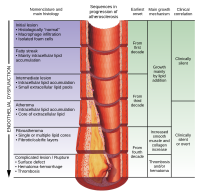
Photo from wikipedia
Cardiovascular disease is the largest single cause of disease-related mortality worldwide and the major underlying pathology is atherosclerosis. Atherosclerosis develops as a complex process of vascular lipid deposition and retention… Click to show full abstract
Cardiovascular disease is the largest single cause of disease-related mortality worldwide and the major underlying pathology is atherosclerosis. Atherosclerosis develops as a complex process of vascular lipid deposition and retention by modified proteoglycans, endothelial dysfunction and unresolved chronic inflammation. There are a multitude of current therapeutic agents, most based on lowering plasma lipid levels, but, overall, they have a lower than optimum level of efficacy and many deaths continue to arise from cardiovascular disease world-wide. To identify and evaluate potential novel cardiovascular drugs, suitable animal models that reproduce human atherosclerosis with a high degree of fidelity are required as essential pre-clinical research tools. Commonly used animal models of atherosclerosis include mice (ApoE−/−, LDLR−/− mice and others), rabbits (WHHL rabbits and others), rats, pigs, hamster, zebrafish and non-human primates. Models based on various wild-type and genetically modified mice have been extensively reviewed but mice may not always be appropriate. Thus, here, we provide an overview of the advantages and shortcomings of various non-mouse animal models of atherosclerotic plaque formation, and plaque rupture, as well as commonly used interventional strategies. Taken together, the combinatorial selection of suitable animal models readily facilitates reproducible and rigorous translational research in discovering and validating novel anti-atherosclerotic drugs.
Journal Title: International Journal of Molecular Sciences
Year Published: 2022
Link to full text (if available)
Share on Social Media: Sign Up to like & get
recommendations!